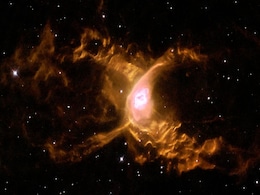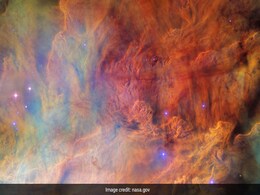Constellation Of Sagittarius
- All
- News
-

NASA Hubble Space Telescope Helps Confirm the First Solitary Black Hole
- Friday April 18, 2025
- Written by Gadgets 360 Staff
In the Sagittarius constellation, a lone and first-ever solitary black hole has been discovered by a team of scientists. Although the discovery began in the year 2011, the observations have confirmed it recently. The size of this black hole is as massive as seven times of the sun. Despite the conflicts and differences of observations by another tea...
-
 www.gadgets360.com
www.gadgets360.com
-

NASA Shares Red Spider Nebula Photos, Showcasing Fiery Colours and Massive Shockwaves
- Friday September 13, 2024
- Written by Gadgets 360 Staff
NASA has released awe-inspiring photos of the Red Spider Nebula, located 3,000 light-years away in the constellation of Sagittarius. The nebula, with its vibrant red hues and spider-like structure, showcases shockwaves as high as 62 billion miles, created by one of the hottest stars known. This celestial marvel has left the internet buzzing, with s...
-
 www.gadgets360.com
www.gadgets360.com
-

NASA Shares Fascinating Pics Of Red Spider Nebula, Leaves Internet Awestruck
- Thursday September 12, 2024
- Science | Edited by Ritu Singh
Located approximately 3,000 light-years away in the constellation Sagittarius, this planetary nebula is home to one of the most scorching stars in the universe.
-
 www.ndtv.com
www.ndtv.com
-

European Space Agency Wishes Holi With Pictures Of "Cosmic Colours"
- Wednesday March 8, 2023
- Feature | Edited by Anoushka Sharma
The European Space Agency (ESA) participated in Holi celebration and shared pictures of two colourful nebulae captured by the Hubble Space Telescope.
-
 www.ndtv.com
www.ndtv.com
-

NASA's Hubble Space Telescope Captures Breathtaking Images Of A Star-Studded Cosmic Cloud
- Saturday December 17, 2022
- World News | Edited by Nikhil Pandey
The stars seen throughout are part of the cluster NGC 6530, located about 4,350 light-years away.
-
 www.ndtv.com
www.ndtv.com
-

NASA's Hubble Captures Image of Giant Star, 32 Times the Size of the Sun, at the Centre of Lagoon Nebula
- Wednesday May 18, 2022
- Edited by Gadgets 360 Newsdesk
NASA has recently shared an image that showed the world around Herschel 36. The image featured a cosmic landscape that appears to be incredibly serenic, but the region is full of turbulence as well. This star is at the centre of the Lagoon Nebula, a giant interstellar cloud in the constellation Sagittarius and located around 4,000 light-years away.
-
 www.gadgets360.com
www.gadgets360.com
-

Hubble Discovers a Little Gem in Space
- Monday August 10, 2015
- World News | Indo-Asian News Service
NASA's Hubble telescope has stumbled upon a little colourful gem nebula - an interstellar cloud of dust, hydrogen, helium and other ionised gases.
-
 www.ndtv.com
www.ndtv.com
-
NASA discovers new black hole in Milky Way
- Sunday October 7, 2012
- World News | Press Trust of India
NASA's Swift satellite has found evidence of the presence of a previously unknown stellar-mass black hole in our Milky Way galaxy. Named Swift J1745-26 after the coordinates of its sky position, the nova is located a few degrees from the centre of our galaxy towards the constellation Sagittarius, NASA said.
-
 www.ndtv.com
www.ndtv.com
-

NASA Hubble Space Telescope Helps Confirm the First Solitary Black Hole
- Friday April 18, 2025
- Written by Gadgets 360 Staff
In the Sagittarius constellation, a lone and first-ever solitary black hole has been discovered by a team of scientists. Although the discovery began in the year 2011, the observations have confirmed it recently. The size of this black hole is as massive as seven times of the sun. Despite the conflicts and differences of observations by another tea...
-
 www.gadgets360.com
www.gadgets360.com
-

NASA Shares Red Spider Nebula Photos, Showcasing Fiery Colours and Massive Shockwaves
- Friday September 13, 2024
- Written by Gadgets 360 Staff
NASA has released awe-inspiring photos of the Red Spider Nebula, located 3,000 light-years away in the constellation of Sagittarius. The nebula, with its vibrant red hues and spider-like structure, showcases shockwaves as high as 62 billion miles, created by one of the hottest stars known. This celestial marvel has left the internet buzzing, with s...
-
 www.gadgets360.com
www.gadgets360.com
-

NASA Shares Fascinating Pics Of Red Spider Nebula, Leaves Internet Awestruck
- Thursday September 12, 2024
- Science | Edited by Ritu Singh
Located approximately 3,000 light-years away in the constellation Sagittarius, this planetary nebula is home to one of the most scorching stars in the universe.
-
 www.ndtv.com
www.ndtv.com
-

European Space Agency Wishes Holi With Pictures Of "Cosmic Colours"
- Wednesday March 8, 2023
- Feature | Edited by Anoushka Sharma
The European Space Agency (ESA) participated in Holi celebration and shared pictures of two colourful nebulae captured by the Hubble Space Telescope.
-
 www.ndtv.com
www.ndtv.com
-

NASA's Hubble Space Telescope Captures Breathtaking Images Of A Star-Studded Cosmic Cloud
- Saturday December 17, 2022
- World News | Edited by Nikhil Pandey
The stars seen throughout are part of the cluster NGC 6530, located about 4,350 light-years away.
-
 www.ndtv.com
www.ndtv.com
-

NASA's Hubble Captures Image of Giant Star, 32 Times the Size of the Sun, at the Centre of Lagoon Nebula
- Wednesday May 18, 2022
- Edited by Gadgets 360 Newsdesk
NASA has recently shared an image that showed the world around Herschel 36. The image featured a cosmic landscape that appears to be incredibly serenic, but the region is full of turbulence as well. This star is at the centre of the Lagoon Nebula, a giant interstellar cloud in the constellation Sagittarius and located around 4,000 light-years away.
-
 www.gadgets360.com
www.gadgets360.com
-

Hubble Discovers a Little Gem in Space
- Monday August 10, 2015
- World News | Indo-Asian News Service
NASA's Hubble telescope has stumbled upon a little colourful gem nebula - an interstellar cloud of dust, hydrogen, helium and other ionised gases.
-
 www.ndtv.com
www.ndtv.com
-
NASA discovers new black hole in Milky Way
- Sunday October 7, 2012
- World News | Press Trust of India
NASA's Swift satellite has found evidence of the presence of a previously unknown stellar-mass black hole in our Milky Way galaxy. Named Swift J1745-26 after the coordinates of its sky position, the nova is located a few degrees from the centre of our galaxy towards the constellation Sagittarius, NASA said.
-
 www.ndtv.com
www.ndtv.com








